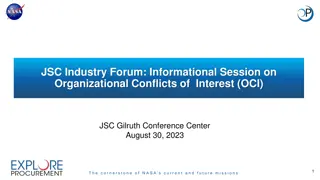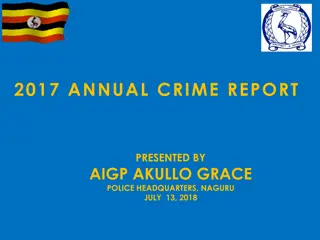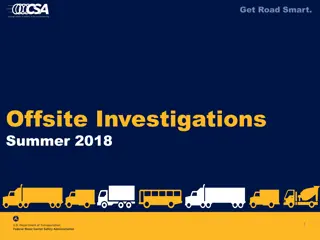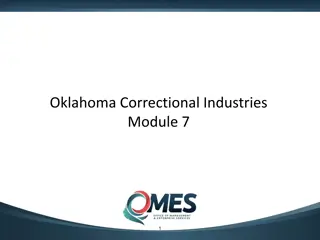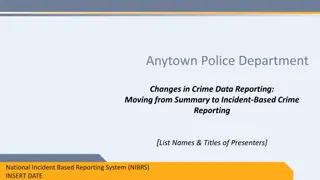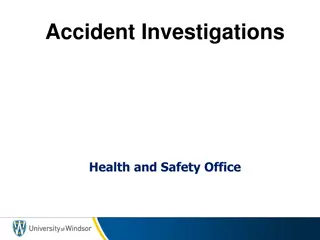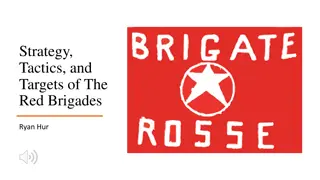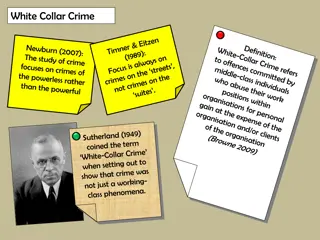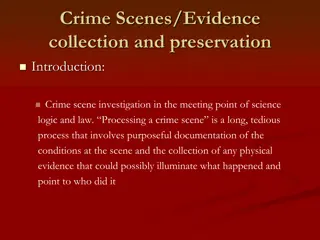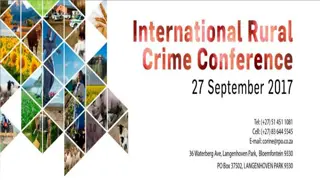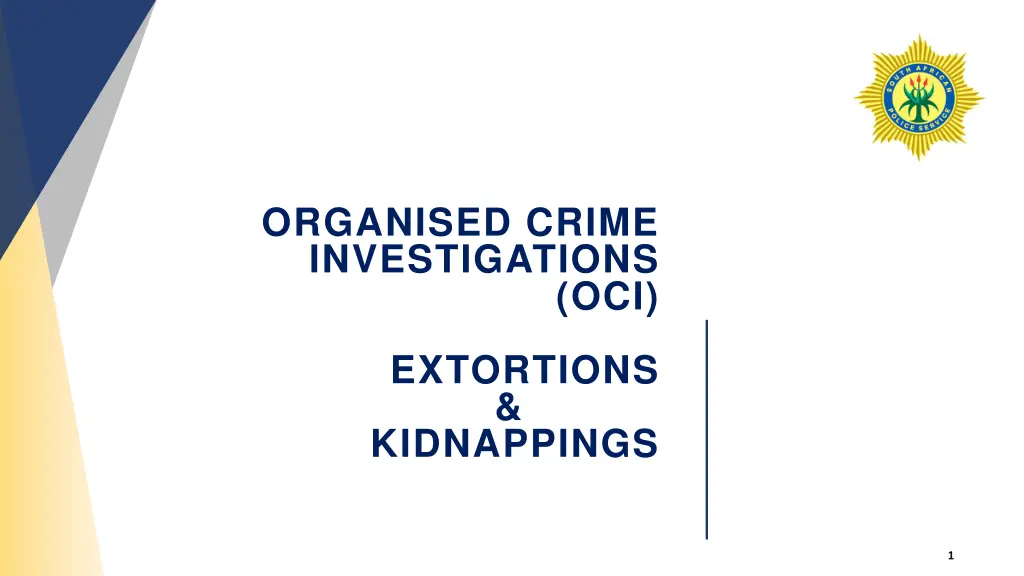
Understanding Organised Crime Investigations on Extortions and Kidnappings
Explore the rise of criminal elements in South Africa's construction industry, including extortion tactics used by construction mafias and local business forums. Learn about interventions to address these crime trends and protect economic sectors from disruption and violence.
Uploaded on | 0 Views
Download Presentation

Please find below an Image/Link to download the presentation.
The content on the website is provided AS IS for your information and personal use only. It may not be sold, licensed, or shared on other websites without obtaining consent from the author. If you encounter any issues during the download, it is possible that the publisher has removed the file from their server.
You are allowed to download the files provided on this website for personal or commercial use, subject to the condition that they are used lawfully. All files are the property of their respective owners.
The content on the website is provided AS IS for your information and personal use only. It may not be sold, licensed, or shared on other websites without obtaining consent from the author.
E N D
Presentation Transcript
ORGANISED CRIME INVESTIGATIONS (OCI) EXTORTIONS & KIDNAPPINGS 1
PURPOSE The purpose of this presentation is provide overview of the extortion at the construction site, kidnappings and update on the interventions to curb the crime trends in the country. 2
INTRODUCTION South Africa s construction industry, which is a significant driver of economic growth, development and employment, has seen a rise in criminal elements, known as the construction mafias and extortionists. Construction sites, ranging from small businesses to large-scale projects, serve as prime targets for these organised crime syndicates. Their tactics include extortion, violence, intimidation and disruption, to advance their objectives. Furthermore, South Africa is increasingly experiencing emerging new kind of criminality in the form of organised groups targeting economic sectors like small foreign-owned businesses, the taxi industry, households and the construction sector in general. These groupings have organised themselves into units known as local business forums and have invaded various sector sites across the country, demanding money or a stake in development projects and also demand protection fees from small businesses, school transportation schemes and households. This impacts negatively on the economy, infrastructure development including investors confidence. These disruptions undermine service delivery and economic development through the delays and threats of violence. It further threatens the livelihood of society at large. 3
BACKGROUND On 19 March 2019, the South African Forum of Civil Engineering Contractors (SAFCEC: an industry body representing JSE listed, non-listed and emerging contractors) wrote to the Presidency, expressing their grave concern that construction projects worth a minimum of R25,5bn are being violently disrupted and harm the investor confidence in the Republic of South Africa s economy. The State President of South Africa his Excellency Cereal Ramaphosa, in his State of the Nation Address delivered on 13 February 2020, announced that he has prioritised government s response to the growing problem of criminal groups that extort money from construction and businesses. The State President reiterated the damage caused by extortion on our economy and directed that stringent measures be put in place by law enforcement agencies. This led to the establishment of specialised police teams which were directed to tackle this threat. The combating of extortion and violence directed at economic sites especially the Construction Sector is one of the deliverables to the National Development Plan 2030. The Justice, Crime Prevention and Security Cluster ( JCPS) has been tasked as an implementing agency, in this regard. 4
DEFINITION OF EXTORTION Common law definition: Unlawful and intentional obtaining of some advantage, which may be patrimonial or non patrimonial in nature from another by subjecting the latter to pressure which induces him or her to hand over the advantage. 5
MODUS OPERANDI Invasion of construction sites, by heavily armed individuals who threaten individuals and families. Demand for community employment and 30% share inclusion of Small Medium Micro Enterprises (SMME s), in projects. Forceful demand for tenders and protection fees. Intimidation /threatening of contractors to cease their duties at construction sites. Threatening of business people to pay funds for security, so that their businesses are not disrupted or destroyed. Violent conduct resulting to murders and attempted murders. Barricade roads/forced shut down of construction sites. Theft and armed robbery of contractors equipment or criminals demands payment for graders/construction machinery to be at construction sites. Destruction of water infrastructure, so that they continue to offer or supply water, under municipal contracts. 6
EXTORTION TYPOLOGY CONSTRUCTION SECTOR Construction mafia disrupts construction sites across the country where they present themselves as an emerging business forums. The group invades construction sites and demands money or a stake in development projects (Mainly roads and building constructions) MINING SECTOR Mining companies like Anglo American Plc, Glencore Plc and Sibanye Stillwater Ltd are targets for groups demanding as much as 30% of their lucrative procurement contracts, often with little to offer by way of skills and services. Non-compliance brings threats to executives and disruptions in operations SECURITY SECTOR Security companies involved in government and private businesses are targets where these group demand 30% of the contracts or otherwise threats are made to security guards and managers of the businesses CONFIDENTIAL
EXTORTION TYPOLOGY TRANSPORT SECTOR Bucket system by chairpersons of associations. Taxi drivers or owners approach scholar transport and demand a share per load. BUSINESS SECTOR Protection money is being extorted from foreign-owned businesses, spaza shops, petrol stations and even backyard dwellers who have jobs particularly in townships. MUNICIPALITY These groupings storms into boardrooms while the Bid Evaluation Committee (BEC) meetings are in session and demand tenders and threatens supply chain management officials. VULNERABLE COMMUNITY The Extortionists are targeting vulnerable community groups like the disabled and blind people, Road Accident Fund and pension pay outs recipients, where they identify them and extort money from them. Informal farmers and certain vehicle type owners are also targeted for protection fees. 8
OPERATIONAL APPROACH Organised Crime can be prevented, combated and investigated as major or project investigations in the form of a multidisciplinary approach that includes all security clusters, government departments, private institutions, financial institutions, Non Government Organizations (NGOs) and Non Profit Organizations (NPOs) stake holders. It requires proactive approach based on criminal intelligence, threat analysis, identification of syndicates and criminal grouping, searching, interviews, interrogations, evidence collection and preservation are the requirements. Useful tools to determine organised crime links are informants, surveillance and undercover investigations. This includes disrupting, dismantling and neutralising syndicates involved in identified organised criminal activities utilising unconventional methods, under cover operation, electronic surveillance and use of informants. 9 To involve Asset Forfeiture Unit to address the seizure and confiscation of illicit proceeds of crime
OPERATIONAL APPROACH In order to address and curb the identified threats the Integrated Multi-Disciplinary Approach must be implemented as follows: The approach is based on the method of integrating all relevant disciplines (Operational Analysts, Information collectors, Investigating Officers, Forensic Analysts, Ballistic Analysts, Communication Analysts, Digital Forensic Analysts, Designated Firearm Officer, Combat and Operational Support) from SAPS into a Centralised Command Structure. Establish dedicated capacity from other stakeholders i.e. NPA (Prosecutors and Witness Protection Programme Officers), Correctional Services) Analysis of the docket and compilation of each docket action plan by the operational analysts and investigating officers (this is to identify repeated offenders, modus operandi, new trends.) Allocate the case dockets to teams made up of two investigating officers or more (individual investigation not recommended). 10
OPERATIONAL APPROACH The team leader to meet with the investigation team on a weekly basis with the assigned prosecutor. To give progress on the dockets and the assigned prosecutor to give further directives in accordance to tasking's aimed at collecting evidence to link identified suspects with the case that are discussed and issued to various teams, to monitor accountability. Conduct regular Prosecutor Guided Investigations until the finalization of the case. The investigation team to ensure that all the investigative tools such as statement/timeline analysis reports, forensic reports, ballistic reports, communication analysis reports, cell phone and video extracts are optimally utilized. 11
OPERATIONAL APPROACH Proper Implementation of Pillar 4 which is investigation that includes Organised Crime Approach At the initial stage, investigate the motive to establish elements of crime relating to extortion. Identify possible suspect/s. Engage Crime Intelligence (CI) for profiling of the identified suspect/s, to identify the threats and new trends. Create an organogram placing the identified possible suspects on their respective roles and obtain their detailed profiles and collection of evidence to link each identified suspect. Optimal utilization of investigative aids Proper crime scenes management, coordination of the fingerprints process and other forensic leads/evidence for identified crime scenes (in case of shooting incidents). Analysis and examination by experts in support of the investigation i.e. ballistic analyst, digital forensic analyst, and Section 205 data analyst. 12
OPERATIONAL APPROACH To neutralise the threat (perpetrators) further concepts are utilised as follows: Man-Marking concept Identify the involvement of suspects through information gathering Conduct profiles to identify previous cases that were withdrawn to resuscitate the cases. Analyse all cases against the suspect/s to identify similarities on cartridge cases, modus operandi, vehicles, etc. Collect evidence to link the suspect/s to as many cases as possible. Arrest and charge the suspects. Monitoring of data integrity. 3 SECRET 13
OPERATIONAL APPROACH Opposition of Bail Conduct bail investigation including criminal records of the suspects. Ensure court attendance by investigating team. Prepare oral evidence in terms of aggravating factors that will ensure bail is denied Preparation of bail opposition in conjunction with the assigned prosecutor. Enforcement of Firearms Control Act, Act No. 60 of 2000 Profile suspects to determine ownership of firearms Conduct compliance inspection on the identified suspects/security companies Submit firearms for ballistic testing 14
HOTSPOT DISTRICTS Identified Business Forums and Syndicates - Extortion Top Four Provinces And Districts - Extortion: PROVINCES HOTSPOTS Johannesburg District KZN 20 WC 10 GAUTENG Tshwane District Ekurhuleni District City of Cape Town District GP 9 LP 5 WESTERN CAPE Cape Winelands District Overberg District Buffalo City District NW 3 MP 2 EASTERN CAPE OR Tambo District Nelson Mandela District EC 6 Ethekwini District KWAZULU- NATAL Umgungundlovu District Ugu District 15
COLLABORATIVE APPROACH WITH BUSINESS An Integrated National Priority Committee on Extortions was established in August 2024 made of the public and the private sector. The purpose of the Priority Committee on Extortions is to: direct collaborative efforts, experiences, skills and resources to curb the scourge of extortions in the country. cooperate with the entities in the private sector, within the context of relevant legislative, policy, strategic and operational framework applicable to both SAPS and partners, in order to address the growing problem of extortionist criminal groups that target construction and other business sites. 16
STAKEHOLDERS South African Police Service (VISPOL and Crime Intelligence, Supply Chain Management). Directorate for Priority Crime Investigation (DPCI). Department of Public Works and Infrastructure (DPWI). National Prosecuting Authority NPA). Asset Forfeiture Unit (AFU). Special Investigating Unit (SIU). South African Revenue Services (SARS.) South African Banking Risk Information Centre (SABRIC.) Financial Intelligence Centre (FIC.) South African National Road Agency (SANRAL). ESKOM. South African Forum of Civil Engineering Contractors (SAFCEC). Minerals Council of South Afric. Digital Council of Africa. South African Pulp and Paper Industry (SAPPI). Business Against Crime South Africa (BACSA). Wilson Baily Holmes (Pty) LTD (WBHO). Professional Management Support OPS (Pty) LTD. Consumer Goods Council of South Africa (CGCSA). Bargaining Council for Civil Engineering Industry (BCCEI). Construction Industry Development Board (CIDB. 17
WORK STREAMS Stakeholder Engagement and Awareness Training and Development Prevention of Organised Crime Act Case Management SAPS and the NPA Information Management Legislative Review Work streams are based on the traditional five pillar approach operational methodology 18
Work Streams Functions Provide crime intelligence and technical support for the effective detection of crime. Gather, correlate, evaluate, co-ordinate and use crime intelligence in support of the detection of crime. Effective and efficient intelligence co-ordination. Proactive competencies (crime prevention and combating). The successful arrest and prosecution of criminal groupings identified in Extortion and related crimes and ensure that the proceeds of crime are forfeited to the state. Effective and efficient investigation of Extortion related crimes and ensure that the proceeds of crime are forfeited to the state. Case Management (database). Work Stream 1: Information Sharing Work Stream 2: Case Management Work Stream 3: Training and Development Training of SAPS members, other stakeholder as well as industry. Skills transfer and empowerment. Work Stream 4: Stakeholder Engagement and Awareness Community mobilisation and advocacy through communication. Enhance communication initiatives to promote interventions addressing the objectives of the plan. To ensure prosecution in terms of Prevention of Organised Crime Act, Act 121 of 1998. Focussing on the identified targets and forfeiture of assets acquired with proceeds of crime including Money Laundering of all extortion related cases. Work Stream 5: POCA Work Stream 6: Legislative Review Interrogate current legislation and identify gaps that renders this threat pervasive. 19
INVESTIGATIVE CAPACITY Component: Organised Crime Investigations has established Extortion investigation teams in all nine (09) Provinces to combat, prevent and investigate Extortion and extortion related cases. The new approved SAPS organisational structure made provision for Extortion Units within the Component: Organised Crime Investigations. 20
INCIDENT REPORT Between 1 April 2019 and 31 March 2024, the total number of reported extortion cases across South Africa reached 6,056. Gauteng was the highest contributor, recording 2,284 cases, which accounted for nearly 38% of the national total. This province saw 828 arrests and 45 convictions, highlighting a significant level of extortion activity. The Western Cape was the second highest, with 1,476 reported cases, 683 arrests, and 36 convictions, making up approximately 24% of the total reports. 21
INCIDENT REPORT Nationally, these reports culminated in 2,383 arrests and 177 guilty verdicts, with Gauteng and the Western Cape being the highest contributors to the national figures. These two provinces alone accounted for over 60% of all reported extortion cases in the country. The extortion at the construction site accounted for 1,89% of the reported extortion cases. 22
CENTRALIZATION OF ALL EXTORTION DOCKET Engagement with the Deputy National Director of Public Prosecutions on the centralisation of dockets yielded the following directive: DNDPP has engaged all DPPs for prosecutorial guided investigation. All outstanding extortions dockets are presented to the NPA . There is continues engagement based on the outcome of the docket analysis. 23
INTERVENTIONS AT HOTSPOT AREAS Operation Silapha Eastern Cape: National multidisciplinary deployment based on the five pillar approach in Nelson Mandela bay and OR Tambo. 104 members deployed (including detectives and crime intelligence). Key objective: Threat stabilization with arrests. Successes recorded: seizures and arrests. 24
EXTORTION HOTLINE National Hotline was established on 28 October 2024, Western Cape Hotline was established on 1 April 2024 and Eastern Cape Hotline was established on 23 August 2024. The hotline were introduced to facilitate speedy reporting and response to incidents. The hotline resulted in arrests of several suspects and averting stoppages of the projects. However there is challenges experienced by the hotline of prank calls , people verifying the hotline number and reporting of extortion unrelated cases For an example during the financial year 2024 /2025 in the Eastern Cape province a total of 5119 calls were received of which 3049 were false calls,1614 verification calls and 767 extortion unrelated incident. 25
MEASURES TO BE EFFECTED AGAINST PRANK CALLS Public Awareness Campaigns Educate the Public: SAPS Corporate Communication and Liaison will continuously Launch public awareness campaigns emphasizing the seriousness of prank calls to emergency lines and the potential legal consequences (such as fines or imprisonment). Public awareness is key because prankster and children may think of it as a joke when in fact it violates certain codes that should have legal consequences. Use Social Media: Use social media platforms to spread the message that prank calling is illegal and dangerous, possibly leading to significant penalties. Marketing the hotline as well as the dangers of pranking will also assist in deterring the pranksters. Using internal Communication, Broadcast as well as Media Relations, we have put strict measures to deal with prankster on all our speeches and media statements that relate to the use of the Hotlines. 26
BACKGROUND KIDNAPPING Incidents of kidnappings related matter increases annually. Vulnerable people are targeted including business people. Majority of cases are committed for ransom, that benefits perpetrators. Kidnapping is associated with deception and violent crime in South Africa e.g. exrtotion,murder,assault. It involves all nationalities both suspects and victims. Kidnapping is committed by organised groups that involves two or more people. Kidnapping is motivated by a need for revenge or cash and it is also associated with other motives. 27
TYPES OF KIDNAPPING RANSOM KIDNAPPING: Victim ids kidnapped with intention to extorts money from the family, either in the form of cash or bitcoins TIGER KIDNAPPING. Robbery involves two separate crimes. The first crime usually involves an abduction of any person or thing someone highly values. Instead of demanding money, the kidnappers demand that a second crime be committed on their behalf. EXPRESSKIDNAPPING. is a method of abduction where a small immediate ransom is demanded, often by the victim being forced to withdraw money from his or her ATM account. VIRTUALKIDNAPPING. Fake kidnapping/ perjury kidnappers pretend as if they kidnapped your family POLITICAL KIDNAPPING. is kidnapping which is conducted to obtain political concessions from security forces or governments BRIDEKIDNAPPING: marriage by abduction or marriage by kidnapper, is a practice in which a man abducts the woman he wishes to marry 28
THE UNITS INVESTIGATING AND THE CRIME TRENDS Eastern Cape - Ransom Kidnapping cases investigated by DPCI. Kidnappings without ransom, investigated by OCI Free State - Investigated by Serious and Violent Crimes (SVC) and DPCI Gauteng - Investigated by Organised Crime Investigations and DPCI Kwa-Zulu Natal - Investigated by DPCI Limpopo - Investigated by OCI Mpumalanga - Investigated by DPCI and CIS Northern Cape - Investigated by SVC and DPCI North West - Investigated by CIS due to capacity however OCI provide investigative support. Western Cape - Investigated by OCI 29
KIDNAPPINGS INCIDENTS AND HOTSPOTS Total number of reported cases 18159 with 3524 arrests for the financial year 2024/2025 Eastern Cape 834 cases with 236 arrest Highest to Lowest Free State 622 cases with 283 arrest 1. Gauteng (9647) 2. Kwa-Zulu Natal (3335) 3. Western Cape (1061) 4. Mpumalanga (997) 5. Eastern Cape (834) 6. North West (834) 7. Limpopo (664) 8. Free State (662) 9. Northern Cape (165) Gauteng 9647 cases with 1191 arrests 3335 cases with 963 arrest Kwa-Zulu Natal Limpopo 664 cases 260 arrests Mpumalanga 997 cases 260 arrests Northern Cape 165 cases 66 arrests 834 cases 212 arrests North West 1061 cases 313 arrests Western Cape 30
CHALLENGES: KIDNAPPINGS Families of the victims do not want to co-operate with the police due to the fact that the suspects might find out and they will injure / kill the victim Late reporting by the next of kin of the victim/s. Ransom payments are done without police knowledge or involvement Language barrier at times remains a challenge whereby essential information lost will compromise the investigation Some victims have returned to their countries of origin soon after being released by the suspects 31
THANK YOU THANK YOU 32

